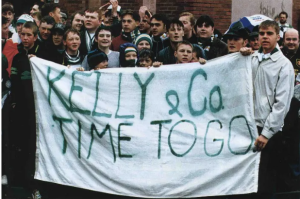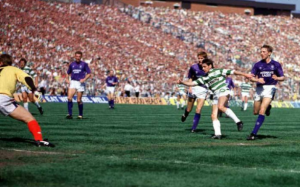Few could have predicted the downfall the team would eventually experience as the Celts celebrated their centenary season in 1987–88. A Rangers triple was prevented by Joe Miller’s goal in the 1989 Sottish Cup Final, but the Ibrox team would go on to rule the 1990s. It would take until 1995 for Celtic to win another trophy.
The club’s financial situation was even more dire than these awful on-field displays. Rangers’ revenue from sales was twice as high as Celtic’s by 1992. Furthermore, Partick Thistle was valued at four times the value of Celtics when it came to the evaluation of their assets!
The answer to this, for Celtic supporters, was obvious: a whole new Board was required, one that could bring in fresh talent and, more crucially, funding. In addition to the average supporters, wealthy businesspeople also desired change. Men like Brian Dempsey, John Keane, and Willie Haughey were also active, although Fergus McCann and Gerald Weisfeld were prominent figures in this.
Different strategies were used by Celtic’s potential leaders to bring about this transformation. Some attempted direct talks with the Celtic board, making an offer to purchase their shares so they could become the owners of the Hoops. Others tried to obtain a foothold in the club by going after lesser shareholders all across the world.
Travelling all over the world, he frequently spoke with stockholders who held shares only because of a great-ancestor they had never met and seldom gave much thought to. These shares were located in several other nations, including the USA, Canada, and Ireland. As a matter of fact, Irish “rebels” advisor David Low wrote about a meeting in which he attempted to purchase shares.

Though not enough to bring about the changes the rebel groups desired, all of these attempts succeeded in giving them a significant Celtic ownership. This is not to suggest that everything was OK within the Board; rather, disagreements and factionalism were tearing them apart.
This was so prevalent that several board members called an extraordinary general meeting (EGM) in March 1992. Its goal was to remove James Farrell and Tom Grant, two more Board members. Actually, this strategy didn’t work and ultimately made it more difficult for the rebels to take over the club.
The Celtic board seemed to experience a sudden emergence of togetherness after this EGM. Five of the primary shareholders and directors of the club decided on a pact to unite their shares. This involved Kevin Kelly, Michael Kelly, Chris White, Tom Grant and David Smith. It meant no-one could sell their shares to people such as McCann, or vote against any move which would dilute the board’s control.
The “Celtic families” maintained their belief that they could control Celtic’s future and unveiled a plan that they said would revolutionise the Bhoys and create a club fit for the twenty-first century. A “Field of Dreams,” a new stadium in Cambuslang, was planned, and Celtic would have moved into what would have been the third Celtic Park.
The “rebels'” next move was to attempt to compel a fresh share issue. They felt that this would terminate the family dynasties’ control on Celtic and raise the important figures that the club required. Unusual locations for planning discussions included Queen Street station’s Casey Jones Burgers (named after the nineteenth-century US railroad driver).

An EGM was held again in November 1993, this time to vote on a proposition to establish a new share issue. The Celtic board would not permit such a thing, particularly the “Gang of five.” The legal agreement they had signed barred even any one of them from doing this, even if they so desired. In other words, the rebel scheme was doomed from the start.
Other causes would need to take the lead if there was to be any change at Celtic. And the supporters took the lead in this regard. In the end, the Bank of Scotland and Willie Falconer, a Celtic player, both unintentionally, had a significant impact.
Although the Save our Celts campaign had garnered media attention and experienced some early wins, its momentum was starting to flag. It was replaced by Celts for Change, a group founded in September 1993 with the intention of giving voice to the growing resentment among fans. They took part in a variety of events, including rallies, protest marches, and the dropping of flyers.
The end was drawing near. Would it spell the end for Celtic as a whole, or just the old Board?
Leave a Reply